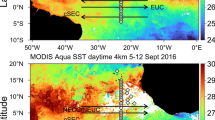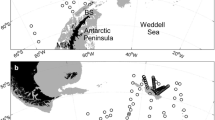Abstract
Chaetognaths are among the most abundant predators in the Southern Ocean and are potentially important components in the biological carbon pump due to the production of large, fast-sinking fecal pellets. In situ S. gazellae abundance, fecal pellet production, sinking rates, carbon content, and vertical carbon fluxes were measured at the Lazarev Sea between December 2005 and January 2006. Sagitta gazellae produce fecal pellets that sink at speeds of 33–600 m day−1 and have carbon contents of 0.01–0.8 mg C pellet−1. Vertical carbon flux was later compared with the total carbon flux measured at 360 m depth at the study area. Rough estimates using published seasonal abundance of S. gazellae indicate that, at 360 m depth in the Lazarev Sea, this specie may contribute 12 and 5% of the total vertical carbon flux in winter (ice-covered) and summer (ice-free), respectively. Thus, the role of chaetognaths in the downward transport of organic matter may be far more important than previously thought.








Similar content being viewed by others
References
Bajkov AD (1935) How to estimate the daily food consumption of fish under natural conditions. Trans Am Fish Soc 65:288–289
Besiktepe S, Dam HG (2002) Coupling of ingestion and defecation as a function of diet in the calanoid copepod Acartia tonsa. Mar Ecol Prog Ser 229:151–164
Boyer SN (1994) Aerobic and anaerobic degradation and mineralization of 14C-Chitin by water column and sediment inocula of the York River Estuary, Virginia. Appl Environ Microbiol 60(1):174–179
Bruland KW, Silver MW (1981) Sinking rates of fecal pellets from gelatinous zooplankton (salps, pteropods, doliolids). Mar Biol 63:295–300
Butler M, Dam HG (1994) Production rates and characteristics of fecal pellets of the copepod Acartia tonsa under simulated phytoplankton bloom conditions: implications for vertical fluxes. Mar Ecol Prog Ser 114:81–91
Cadée GC, González HE, Schnack-Schiel SB (1992) Krill diet affects faecal string settling. Polar Biol 12:75–80
Christian JR, Karl DM (1995) Bacterial ectoenzymes in marine waters: activity ratios and temperature responses in three oceanographic provinces. Limnol Oceanogr 40(6):1042–1049
Connolly JP, Coffin RB (1995) Model of carbon cycling in planktonic food webs. J Environ Eng 121:682–690
Cosper TC, Reeve MR (1975) Digestive efficiency of the chaetognath Sagitta hispida Conant. J Exp Mar Biol Ecol 17:33–38
Crelier AM, Daponte MC (2004) Chaetognatha of the Brazil-Malvinas (Falkland) confluence: distribution and associations. Iheringia Ser Zool 94(4):337–348
David PM (1955) The distribution of Sagitta gazellae Ritter-Zahony. Disc Rep 27:235–278
David PM (1958) The distribution of the Chaetognatha of the Southern Ocean. Disc Rep 29:200–229
Dilling L, Alldredge AL (1993) Can chaetognath fecal pellets contribute to carbon flux? Mar Ecol Prog Ser 92:51–58
Donnelly J, Torres JJ, Hopkins TL et al (1994) Chemical composition of Antarctic zooplankton during austral fall and winter. Polar Biol 14:171–183
Falk-Petersen S, Sargent JR, Lønne OJ et al (1999) Functional biodiversity of lipids in Antarctic zooplankton: Calanoides acutus, Calanus propinquus, Thysanoessa macrura and Euphausia crystallorophias. Polar Biol 21:32–47
Feigenbaum DL (1982) Feeding by the chaetognath, Sagitta elegans, at low temperature in Vineyard Sound, Massachusetts. Limnol Oceanogr 27:699–706
Fischer G, Futterer D, Gersonde R et al (1988) Seasonal variability of particle flux in the Weddell Sea and its relation to ice cover. Nature 335:426–428
Fowler SW, Knauer GA (1986) Role of large particles in the transport of elements and oceanic compounds through the oceanic water column. Prog Oceanogr 16:147–194
Fowler SW, Small LF (1972) Sinking rates of euphausiid fecal pellets. Limnol Oceanogr 17:293–296
Froneman PW, Pakhomov EA (1998) Trophic importance of the chaetognaths Eukrohnia hamata and Sagitta gazellae in the pelagic subsystem of the Prince Edward Islands in late austral summer 1996. Polar Biol 19:242–249
Froneman PW, Pakhomov EA, Perissinotto R et al (1998) Community structure and predation impact of two chaetognath species, Sagitta gazellae and Eukrohnia hamata in the vicinity of the Prince Edward Archipelago (Southern Ocean). Mar Biol 131:95–101
González HE, Smetacek V (1994) The possible role of the cyclopoid copepod Oithona in retarding vertical flux of zooplankton faecal material. Mar Ecol Prog Ser 113:233–246
Granata TC, Dickey TD (1991) The fluid mechanics of copepod feeding in a turbulent flow: a theoretical approach. Prog Oceanogr 26:243–261
Hagen W (1988) On the significance of lipids in Antarctic zooplankton. Ber Polar Forsch 49:1–129
Hagen W (1999) Reproductive strategies and energetic adaptations of polar zooplankton. Invertebr Reprod Dev 36:25–34
Harding GCH (1973) Decomposition of marine copepods. Limnol Oceanogr 18:670–673
Honjo S, Roman MR (1978) Marine copepod fecal pellets: production, preservation and sedimentation. J Mar Res 36:45–57
Hosie GW, Schultz MB, Kitchener JA, Cochran et al (2000) Macrozooplankton community structure off east Antarctica (80–150°E) during the austral summer of 1995/1996. Deep Sea Res II 47:2437–2463
Ikeda T, Kirkwood R (1989) Metabolism and elemental composition of a giant chaetognath Sagitta gazellae from the Southern Ocean. Mar Biol 100:261–267
Kehayias G, Lykakis J, Fragopoulu N (1996) The diets of the chaetognaths Sagitta enfata, S. serratodentata atlantica and S. bipunctata at different seasons in Eastern Mediterranean coastal waters. ICES J Mar Sci 53:837–846
Kimmerer WJ (1984) Selective predation and its impact on prey of Sagitta enflata (Chaetognatha). Mar Ecol Prog Ser 15:55–62
Komar PD, Morse AP, Small LF et al (1981) An analysis of sinking rates of natural copepod and euphausiid fecal pellets. Limnol Oceanogr 26:172–180
Krause M (1981) Vertical distribution of faecal pellets during FLEX ’76. Helgol Meeresunters 34:313–327
Kruse S, Bathmann U, Brey T (2009) Meso- and bathypelagic distribution and abundance of chaetognaths in the Atlantic sector of the Southern Ocean. Polar Biol. doi:10.1007/s00300-009-0632-3
Lampitt RS, Noji T, von Bodungen B (1990) What happens to zooplankton faecal pellets? Implications for material flux. Mar Biol 104:15–23
Legendre L, Michaud J (1998) Flux of biogenic carbon in oceans: size dependent regulation by pelagic food webs. Mar Ecol Prog Ser 164:1–11
Lukáč D (2006) Community structure and predation impact of carnivorous macrozooplankton in the Polar Frontal Zone (Southern Ocean), with particular reference to chaetognaths, Masters thesis, Rhodes University, 135 p
Nagasawa S (1985) The digestive efficiency of the chaetognath Sagitta crassa Tokioka, with observations on the feeding process. J Exp Mar Biol Ecol 87:271–282
Noji TT, Estep KW, MacIntyre F et al (1991) Image analysis of fecal material grazed upon by three species of copepods: evidence for coprorhexy, coprophagy and coprochaly. J Mar Biol Assoc UK 71:465–480
Øresland V (1987) Feeding of the chaetognaths Sagitta elegans and S. setosa at different seasons in Gullmarsfjorden, Sweden. Mar Ecol Prog Ser 39:69–79
Øresland V (1990) Feeding and predation impact of the chaetognath Eukrohnia hamata in Gerlache Strait, Antarctic Peninsula. Mar Ecol Prog Ser 63:201–209
Øresland V (1995) Winter population structure and feeding of the chaetognath Eukrohnia hamata and the copepod Euchaeta antarctica in Gerlache Strait, Antarctic Peninsula. Mar Ecol Prog Ser 119:77–86
Øresland V (2000) Diel feeding of the chaetognath Sagitta enflata in the Zanzibar Channel, western Indian Ocean. Mar Ecol Prog Ser 193:117–123
Pakhomov EA, Froneman PW (2000) Composition and spatial variability of macroplankton and micronekton within the Antarctic Polar Frontal Zone of the Indian Ocean during austral autumn 1997. Polar Biol 23(6):410–419
Pakhomov EA, Perissinotto R, Froneman PW (1999) Predation impact of carnivorous macrozooplankton and micronekton in the Atlantic sector of the Southern Ocean. J Mar Syst 19:47–64
Pakhomov EA, Perissinotto R, McQuaid CD et al (2000) Zooplankton structure and grazing in the Atlantic sector of the Southern Ocean in the last austral summer 1993. Park 1. Ecological zonation. Deep Sea Res I 47(9):1663–1686
Ploug H, Iversen MH, Koski M (2008) Production, oxygen respiration rates, and sinking velocity of copepod fecal pellets: direct measurements of ballasting by opal and calcite. Limnol Oceanogr 53(2):469–476
Priddle J, Smetacek V, Bathmann U (1992) Antarctic marine primary production, biochemical carbon cycles and climatic change. Philos Trans R Soc Lond B 338:289–297
Raymont JEG, Srinivasagam T, Rayrnont JKB (1969) Biochemical studies on marine zooplankton. VI. Investigation on Meganyctiphanes norvegica (M. Sars). Deep Sea Res 16:141–156
Reeve MR (1970) The biology of Chaetognatha 1. Quantitative aspects of growth and egg production in Sagitta hispida. In: Steele JH (ed) Marine food chains. Oliver and Boyd, Edinburgh, pp 168–189
Small LF, Fowler SW, Onlii MY (1979) Sinking rates of natural copepod fecal pellets. Mar Biol 51:233–241
Small LF, Fowler SW, Moore SA et al (1983) Dissolved and fecal pellet carbon and nitrogen release by zooplankton in tropical waters. Deep Sea Res 30:1199–1220
Smayda TJ (1969) Some measurements of the sinking rate of fecal pellets. Limnol Oceanogr 14:621–625
Steur L, Holland DM, Muench RD et al (2007) The warm-water ‘‘Halo’’ around Maud Rise: properties, dynamics and impact. Deep Sea Res I 54:871–896
Terazaki M (1989) Distribution of chaetognaths in the Australian sector of the Southern Ocean during the BIOMASS SIBEX cruise (KH-83–4). Proc NIPR Symp Polar Biol 2:51–60
Terazaki M, Wada M (1988) Occurrence of large numbers of carcasses of the large, grazing copepod Calanus cristatus from the Japan Sea. Mar Biol 97:177–183
Turner JT (2002) Zooplankton fecal pellets, marine snow and sinking phytoplankton blooms. Aquat Microb Ecol 27:75–102
Turner JT, Ferrante JG (1979) Zooplankton fecal pellets in aquatic ecosystems. Bioscience 29:670–677
Urban-Rich J, Hansell DA, Roman MR (1998) Analysis of copepod fecal pellet carbon using a high temperature combustion method. Mar Biol Prog Ser 171:199–208
Uye S, Kaname K (1994) Relations between fecal pellet volume and body size for major zooplankters of the Inland Sea of Japan. J Oceanogr 50:43–49
Wefer G, Fischer G, Fuetterer D et al (1988) Seasonal particle flux in the Bransfield Strait, Antarctica. Deep-Sea Res 35:891–898
Wefer G, Fischer G (1991) Annual primary production and export flux in the Southern Ocean from sediment trap data. Mar Chem 35:597–613
Wefer G, Fischer G, Füetterer D et al (1990) Particle sedimentation and productivity in Antarctic waters of the Atlantic sector. In: Bleil U, Thiede J (eds) Geological history of polar oceans: Arctic versus Antarctic. Kluwer, Dordrecht, pp 363–379
Wilson SE, Steinberg DK, Buesseler KO (2008) Changes in fecal pellet characteristics with depth as indicators of zooplankton repackaging of particles in the mesopelagic zone of the subtropical and subarctic North Pacific Ocean. Deep Sea Res II 55:1636–1647
Yoon WD, Marty J-C, Sylvain D, Nival P (1996) Degradation of faecal pellets in Pegea confoederata (Salpidae, Thaliacea) and its implication in the vertical flux of organic matter. J Exp Mar Biol Ecol 203:147–177
Yoon WD, Kim SK, Han KN (2001) Morphology and sinking velocities of fecal pellets of copepod, molluscan, euphausiid, and salp taxa in the northeastern tropical Atlantic. Mar Biol 139:923–928
Acknowledgments
The authors would like to thank the crew and scientists of R/V ‘Polarstern’ for their help and support during the Lazarev Sea Krill Study (LAKRIS) project. To Dr. V. Siegel for providing RMT 1 + 8 zooplankton samples. The participation of RG was funded by a CONICYT doctoral fellowship, a DAAD fellowship and a POGO-IOC-SCOR travel-fellowship. Additional support from FONDAP-COPAS grant No. 15010007 and the Instituto Antártico Chileno made possible the post-cruise analysis of zooplankton samples grant Gabinete.
Author information
Authors and Affiliations
Corresponding author
Rights and permissions
About this article
Cite this article
Giesecke, R., González, H.E. & Bathmann, U. The role of the chaetognath Sagitta gazellae in the vertical carbon flux of the Southern Ocean. Polar Biol 33, 293–304 (2010). https://doi.org/10.1007/s00300-009-0704-4
Received:
Revised:
Accepted:
Published:
Issue Date:
DOI: https://doi.org/10.1007/s00300-009-0704-4




